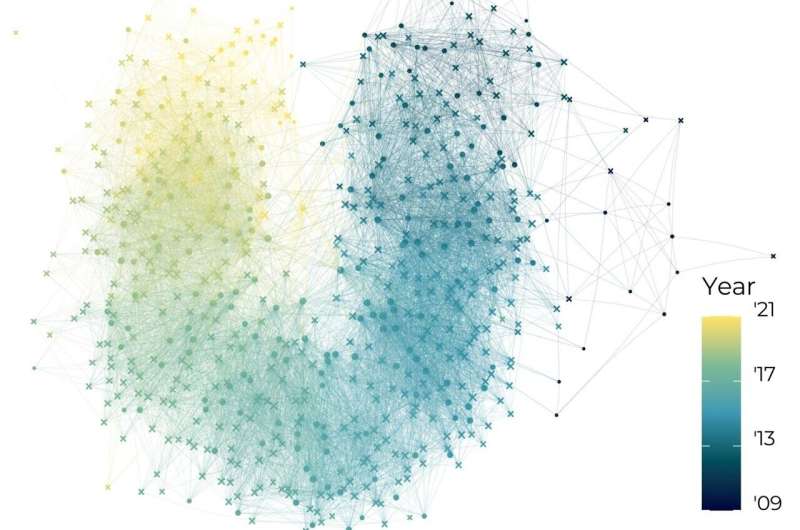This article has been reviewed according to Science X's editorial process and policies. Editors have highlighted the following attributes while ensuring the content's credibility:
fact-checked
peer-reviewed publication
proofread
Film festivals are becoming more diverse in several ways, new study reports

A group of Tallinn University researchers has published an innovative study that sheds light on the intricate dynamics of the global film festival circuit, revealing insights into diversity and public value creation within the industry. The research demonstrates that festival programming has become more thematically diverse, and the inclusion of films by women creatives has increased between 2012–2021.
The study "Quantifying the global film festival circuit: Networks, diversity, and public value creation," published in the PLOS ONE journal, provides a comprehensive analysis of over 600 film festivals worldwide, spanning a period of 13 years. The research, led by Vejune Zemaityte and Andres Karjus, in collaboration with Ulrike Rohn, Maximilian Schich, and Indrek Ibrus, employs network analysis and vector embedding techniques to analyze large-scale festival data from the Cinando platform of the Cannes Film Market.
Film festivals play a crucial role in the film industry, serving as platforms for showcasing diverse cinematic works to audiences ranging from the general public to industry professionals. Despite their significance, international film festivals have remained relatively understudied from a quantitative perspective, with most research relying on qualitative methods or limited datasets.
To address this gap, the study utilized a dataset from the Cinando database, allowing for a detailed examination of festival programming over time. By applying advanced quantitative methods, the researchers were able to quantify diversity in film festival programming across various dimensions, including source diversity (such as origin country and gender of filmmakers) and content diversity (including genre and language).
The findings of the study provide insights into the structure and dynamics of the global film festival network. The research reveals that the festival network is highly interconnected via films, operating on a clear temporal rhythm where programming overlaps primarily between events held one to two years apart.
Furthermore, the study identifies five thematic festival clusters, including general, documentary, genre, queer, and children's festivals, highlighting the diverse range of programming specialization within the circuit.
Geographic and linguistic diversity in festival programming are also examined, with the analysis identifying four broad geographic festival sub-circuits focused on content from Europe, North America, Asia, and Latin America, as well as five linguistic festival groups featuring content in English, Spanish, French, a mix of European languages, and a mix of Asian languages.
The high geographic and linguistic content diversity in the festival circuit separates it from other forms of film distribution, such as theatrical or VOD, that tend to be dominated by English-language content from the US.
While the majority of festivals still exhibit gender imbalances in terms of directors and producers of the programmed films, the research highlighted progress toward gender equity.
The study also compared the diversity of the A-list festivals accredited by the International Federation of Film Producers Associations (FIAPF) and other events and found the programming of the top-tier festivals to be more thematically and linguistically diverse but feature less gender diversity than B-list festivals.
This research underscores the importance of film festivals as creators of public value, serving as spaces for dialogue, encounters, and networking for international film industries. By analyzing diversity in festival programming, the study demonstrates how festivals contribute to fostering cultural exchange and representation, aligning with the public interest in supporting a diverse cultural sphere.
The methodologies showcased in the study offer valuable insights for industry professionals and policymakers. Festival programmers can utilize these techniques to track diversity across various dimensions and identify areas for improvement in their programming practices. Policymakers can leverage these insights to evaluate festival programming records and inform funding decisions aimed at promoting cultural diversity in the film industry.
This study contributes to the field of film festival studies, offering a nuanced understanding of diversity and public value creation within the global film festival circuit. This research builds a foundation for future studies and initiatives aimed at fostering inclusivity and diversity in film festival programming worldwide and underscores the importance of data-driven approaches in understanding cultural events.
More information: Quantifying the global film festival circuit: Networks, diversity, and public value creation, PLoS ONE (2024). journals.plos.org/plosone/arti … journal.pone.0297404
Journal information: PLoS ONE
Provided by Estonian Research Council




















